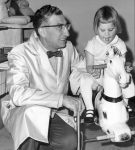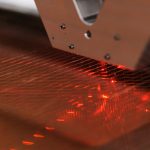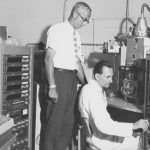Research Highlights 1950 – 1999

In the late 1950s, Kay Emerson became the first person in Wisconsin to be successfully treated for phenylketonuria (PKU). She was treated by Harry Waisman, a PKU researcher and physician and who the Waisman Center is named after.
1950 – Geraldine Harvey earned a Master’s Degree in Education becoming the first known Native American graduate of the university.
1954 – UW–Madison is one of the founding members of the Midwest Universities Research Association that collaborated to design a high-energy acceleratory to be built in the Midwest. In 1967, MURA Laboratory (now known as The Physical Sciences Laboratory) was opened in Stoughton to provide a higher level of technical support than is normally available in University Departments.
1956 – John Bardeen wins the Nobel Prize in Physics for the discovery of the transistor effect.
1958 – UW–Madison is one of the 11 founding members of the Committee on Institutional Cooperation (currently the Big Ten Academic Alliance).
1958 – Joshua Lederberg wins the Nobel Prize in Physiology, Medicine for the genetics of bacteria
1958 – Edward Tatum wins the Nobel Prize in Physiology, Medicine for The metabolism of bacteria, yeasts and molds
1959 – Pharmacy Professor Dale Wurster invents an air suspension coating technique that evenly coats pills to make them more palatable and easier to swallow. The process continues to be widely used in the pharmaceutical industry.
1959 – Explorer 7 is the first successful meteorological satellite experiment. Professors Verner Suomi and Robert Parent’s instrument measured the heat balance of Earth, producing the first climate measurements from space.
1961 – The Biophysics Laboratory (now the Institute for Molecular Virology) is founded by Paul Kaesberg.
1961 –The Wisconsin National Primate Research Center (WNPRC) is formed as part of the National Primate Research Centers program funded by the National Institutes of Health. The WNPRC advances scientific collaboration and discovery, education and training. It provides compassionate and expert animal care while contributing to improving human and animal health and quality of life from early development through aging.
1961- Biochemistry Professor John W. Suttie determines the link between blood clotting protein and vitamin K, which not only accelerated medically important research around blood clotting but also was a landmark achievement in the nutritional sciences. His lab also provided a baseline for assessing hazards, defining emission standards and enacting regulations of fluoride emissions around the country. For information about Suttie’s work in science policy and advocacy, visit: https://biochem.wisc.edu/news/2021/news-remembering-suttie-2021-01-28.
1963 – E.P. Wigner wins the Nobel Prize in Physics for contributions to theories of the atomic nucleus and elementary particles through the discovery and application of fundamental symmetry principles
1964 – The University of Wisconsin Water Resources Institute is founded as part of the National Institute for Water Resources.
1965 – John R. Cameron and Richard Mazess, emeriti professors of medical physics, along with other UW researchers, develop new techniques to measure osteoporosis, allowing better detection, prevention and treatment of bone diseases.
1965 – The University of Wisconsin Board of Regents establishes the Space Science and Engineering Center with Professor Verner Suomi as its first director.
1966 – Professor Eugene Cameron launches the Microbeam Analysis Lab (today, Electron Microbeam Labs) with the installation of an Electron Probe Microanalyzer, an advanced scientific instrument that would measure the chemistry of the first lunar samples returned from the Apollo 11 mission and establish UW-Madison as a leader in chemical analysis of geologic and engineered materials. Everett Glover would provide the expertise to run the lab for the first two and a half decades.
1966 – ATS-I , Verner Suomi’s Spin-Scan Cloud Camera, pioneers continuous viewing of weather from space, revolutionizing forecasting.
1966 – Robert M. Bock launches the Laboratory of Molecular Biology (later the LCMB and today the Center for Quantitative Cell Imaging (CQCI)).
1967 – The Biotron opens as the first research building in which environmental conditions such as temperature, humidity, airflow and length of day can be precisely controlled for experimental purposes.

Tiny woven wires that make up a prototype neutrino-target screen designed at the Physical Sciences Lab. This prototype screen was the basis for more than 120 such target panels that PSL created for the Long-Baseline Neutrino Experiment. (Photo by Jeff Miller/UW-Madison)
1967 – Physical Sciences Laboratory is founded as a research and development lab.
1967 – ATS-III, Verner Suomi’s Multi-Color Spin-Scan Cloud Camera, returns the first color images of Earth from space.
1968 – The UW’s Space Astronomy Laboratory constructs the world’s first true observatory in space – the Orbiting Astronomical Observatory.
1968 – Professor Hector DeLuca’s laboratory synthesizes a metabolized form of vitamin D, dubbed a “super-vitamin,” which leads to the discovery that vitamin D is part of a complex endocrine process.
1968 – Biochemist Har Gobind Khorana shares the Nobel Prize in Physiology and Medicine for research essential to understanding how DNA is translated into proteins. His work at the Institute for Enzyme Research completed the puzzle of which particular nucleic acid sequences code for each of the 22 amino acids that make up all proteins. He was also the first person to synthesize a gene chemically.
1968 – The School of Business launches the country’s first graduate program in arts administration.
1972 – The Business School launches the first graduate program in health-care fiscal administration.
1972 – Stanford Moore wins the Nobel Prize in Chemistry for research on the structure of ribonuclease, a complex protein
1972 – John Bardeen wins a second Nobel Prize in Physics for research on superconductivity
1972 (until 2007) – Earthwatch Radio from Wisconsin Sea Grant continuously provides free weekly environmentally focused programs. At its peak, the program was broadcast by more than 160 radio stations, reaching hundreds of thousands of listeners in the U.S. and around the world. Among its many awards was being named to the “Global 500 Roll of Honor” by the United Nations Environment Program. Learn more at: https://www.seagrant.wisc.edu/audio/#all-podcasts.
1973 – The Institute on Aging/IOA is founded (originally as the Faye McBeath Institute on Aging and Adult Life) to serve the needs of older people in the community and later becomes a leader in multidisciplinary aging research.
1973 – Sapporo Gold, the country’s first artificially produced variety of elm resistant to Dutch Elm diseases, is released.
1973 – The Waisman Center is founded to focus on brain research, human development, and intellectual and developmental disabilities.
1973 – McIDAS, a human-computer Interactive Data Access System, is the first visualization software for satellite data that enables time lapse movies of cloud motions.
1975 – Howard Temin wins the Nobel Prize in Physiology, Medicine for Retroviruses and cancer research.
1975 – The EPA cites the Primate Center team’s findings at its National Conference on Polychlorinated Biphenyls in Chicago. Finally, a 1978 paper by James Allen et al, published in Pharmacology Biochemistry and Behavior, fully describes the toxic effects of PCBs on nonhuman primate health and pregnancy. While no single study led to the landmark ban, several peer-reviewed studies contributed to the building body of evidence that PCBs cause cancer and other serious health problems. https://primate.wisc.edu/news/news-archives/primate-center-research-helped-lead-to-ban-on-pcbs/
1976 – Saul Bellow wins the Nobel Prize in Literature.
1976 – Charles Mistretta, professor of medical physics, develops a method to digitize X-ray images of blood vessels, allowing data to be stored and interpreted by a computer. https://www.warf.org/stories/charles-mistretta/
1977 – John Van Vleck wins the Nobel Prize in Physics for contributions to the development of electronic solid state circuitry and to theories of magnetism and conductivity.
1979 – Theodore Schultz wins the Nobel Prize in Economics for the economics of developing countries.
1980 -–Biochemistry Professor Ann Palmenberg first describes a way to use genetic material called recombinant complementary DNA to make new types of live virus vaccines. Her discovery and application of viral internal ribosome entry sites is the basis for drug production using living cells as protein factories and includes insulin, HGH, interferon, and synthetic antibodies. By studying virus genomes and structures, she helped develop antivirals, vaccines and research reagents used in thousands of labs. https://news.wisc.edu/uw-researchers-honored-as-inventors/.
1980 – NOAA cooperative institute founded at UW–Madison. The UW–Madison Cooperative Institute for Meteorological Satellite Studies is established within the Space Science and Engineering Center in partnership with the National Oceanic and Atmospheric Administration.
1984 – University Research Park is founded to encourage technology transfer and create an endowment for research programs.
1985 – UW–Madison Biotechnology Center opens.
1986 – The Center for Dairy Research is established.
1986 – Folkert Belzer and James Southard develop the UW Solution, a synthetic solution that that allows organs to be preserved outside of the body long enough to be transported.
1987 – The IceCube project, brainchild of UW–Madison Physics Professor Francis Halzen, begins development and leads to the construction of the IceCube Neutrino Observatory. IceCube transformed a cubic kilometer of highly transparent natural Antarctic ice one mile below the South Pole into the largest particle detector ever built, designed to observe the cosmos using neutrinos. https://icecube.wisc.edu/
1990 –UW–Madison horticulturists announce the development of the world’s first genetically altered trees designed to withstand herbicides, holding great promise for the paper and lumber industries.
1991 – Erwin Neher wins the Nobel Prize in Medicine for the discovery of a method to study ion channels in cell membranes.
1993 – John Wiley and John Perepezko develop a thin-film metal barrier that separates copper from aluminum components, fundamentally changing how integrated circuits are manufactured and ushering in a new era of computing. https://www.warf.org/stories/john-wiley-and-john-perepezko/
1993 – U.S. EPA completedsa landmark five-year, $12-million PCB mass balance study of the Green Bay system. It marked the first complete input-output model of all sources, movement and fates of a chemical contaminant in an aquatic system. Wisconsin Sea Grant contributed significant data and field work to the study. In 2022, the EPA gave final certification of PCB cleanup of the Fox River-Green Bay area. That 15-year, $1.2 billion effort was guided by the original research. https://www.seagrant.wisc.edu/news/largest-pcb-cleanup-in-the-world-winding-down/
1994 – Hector F. DeLuca, discoverer of a “super vitamin-D” compound, and colleagues develop biochemical techniques to synthesize the vitamin, opening the way to advances in the treatment of diseases such as osteoporosis.
1995 – James Thomson, VMD, PhD, a scientist at the Wisconsin National Primate Research Center at UW–Madison, became the first in the world to successfully grow nonhuman primate embryonic stem cells. He then used his techniques with monkey cells to become the first to successfully grow human embryonic stem cells. Nearly 25 years later, pluripotent stem cell based treatments have advanced to clinical trials for a number of injuries and diseases and have given us new knowledge about cell biology. Thomson was on the cover of TIME magazine. https://www.pnas.org/doi/abs/10.1073/pnas.92.17.7844 and https://www.science.org/doi/full/10.1126/science.282.5391.1145
1995 – The Midlife in the United States (MIDUS) study, a landmark national longitudinal study, begins. In 2002, the UW–Madison Institute on Aging (IOA) received funding from the National Institute on Aging (NIA) to continue the study. NIA funding has been continuous since then, totaling over $150 million. MIDUS now includes over 11,000 participants assessed repeatedly in multiple domains that link psychosocial and behavioral factors to biomedical and neurological assessments to examine why some face the challenges of aging better than others.
1995 – Ronald E. McNair Postbaccalaureate Achievement Program is established at UW–Madison with a $190,000 grant from the U.S. Department of Education. After being housed in the Graduate School for 23 years, the McNair Program transitioned to the Division of Diversity, Equity and Educational Achievement in 2018. The McNair program creates a bridge to graduate education for undergraduate students and aims to increase the number of students from underrepresented segments of society who earn their Ph.D.
1996 – The Graduate School begins using an electronic application for admission to graduate study via the web for the first time.
1996 – Understanding why and how plants flower has major agricultural and horticultural implications. Biochemistry Professor Rick Amasino and collaborators identify genetic and biochemical pathways that determine when plants begin to flower in the spring. As spring weather becomes less predictable, Amasino’s work can be applied by plant breeders to minimize crop loss and improve horticultural outcomes.
1997 – UW–Madison Chemists Regina Murphy and Laura Kiessling discover how to disrupt the toxicity of proteins that form brain lesions in Alzheimer’s patients, potentially leading to treatment of the disease.
1997 – Paul D. Boyer wins the Nobel Prize in Chemistry for discovery of the process that makes adenosine triphosphate
1997 – Medical Physicist Rock Mackie forms TomoTherapy, a startup company that develops the targeted radiation treatment that revolutionizes the treatment of cancer tumors.
1998 – Biologist Jamie Thompson first cultivates embryonic stem cells in a lab.
1998 – New therapies for presbyopia and glaucoma. Paul Kaufman, School of Medicine and Public Health, has been advancing his therapies through human research and also animal research. https://news.wisc.edu/glaucoma-research-team-receives-prestigious-award/ https://news.wisc.edu/study-advances-gene-therapy-for-glaucoma/
1999 – Guenter Blobel wins the Nobel Prize in Medicine for the discovery of how proteins move into the correct places within a cell.

